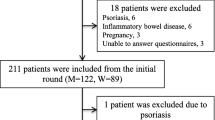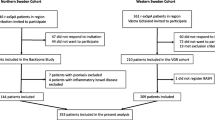Abstract
To determine if obesity is associated with poorer patient-reported outcomes (PROs) in patients with axial spondyloarthritis (axSpA), we conducted a cross-sectional study using data of the PRESPOND registry from a tertiary referral center in Singapore between 2011 and 2015. Demographics, clinical, and PRO variables were collected. Patients were divided into three categories: normal (BMI < 23 kg/m2), overweight (23 kg/m2 ≤ BMI < 27.5 kg/m2) and obese (BMI ≥ 27.5 kg/m2), using Asian BMI classification. The dependent variables are Pain score, Bath Ankylosing Spondylitis Patient Global Score (BAS-G), Bath Ankylosing Spondylitis Disease Activity Index (BASDAI), Bath Ankylosing Spondylitis Functional Index (BASFI), Health Assessment Questionnaire (HAQ), and Medical Outcomes Study Short Form 36 version 2 (SF-36). Multivariate regression analyses were performed with these dependent variables and obesity categories, adjusting for confounders. Among 194 patients with axSpA, 32% are overweight while 22% are obese. We found that obese patients had significant poorer pain (β: 11.87, 95%CI 2.13, 21.60) and BAS-G scores (β: 10.18, 95%CI 1.59, 18.76) when compared to normal BMI patients. However, obesity was not associated with BASDAI (β 0.50, 95%CI -0.22, 1.22), BASFI (β 0.08, 95%CI -0.66, 0.81), HAQ (β -0.07, 95%CI -0.21, 0.06), physical component summary (β -0.02, 95%CI -4.47, 4.44), and mental component summary (β -2.85, 95%CI -7.57, 1.88) of SF-36. Obesity was associated with pain score and BAS-G but not with BASDAI, BASFI, HAQ, and SF-36. Further study is needed to examine the causal relationship between obesity and poorer PROs.
Similar content being viewed by others
References
Spondyloarthritis. Arthritis Foundation. http://www.arthritis.org/about-arthritis/types/spondyloarthritis/Accessed 3 Sept 2016
Stolwijk C, Boonen A, van Tubergen A, Reveille JD (2012) Epidemiology of spondyloarthritis. Rheum Dis Clin N Am 38(3):441–476. doi:10.1016/j.rdc.2012.09.003
Obesity and Overweight. World Health Organization. http://www.who.int/mediacentre/factsheets/fs311/en/ Accessed 3 Sept 2016
WHO (2004) Appropriate body-mass index for Asian populations and its implications for policy and intervention strategies. Lancet (London, England) 363(9403):157–63. DOI: 10.1016/S0140-6736(03)15268-3
Khaodhiar L, McCowen KC, Blackburn GL (1999) Obesity and its comorbid conditions. Clinical cornerstone 2(3):17–31. doi:10.1016/S1098-3597(99)90002-9
Durcan L, Wilson F, Conway R, Cunnane G, O’Shea FD (2012) Increased body mass index in ankylosing spondylitis is associated with greater burden of symptoms and poor perceptions of the benefits of exercise. J Rheumatol 39(12):2310–2314. doi:10.3899/jrheum.120595
Rubio Vargas R, van den Berg R, van Lunteren M, Ez-Zaitouni Z, Bakker PAC, Dagfinrud H et al (2016) Does body mass index (BMI) influence the ankylosing spondylitis disease activity score in axial spondyloarthritis? Data from the SPACE cohort: RMD Open 2(1):e000283. doi:10.1136/rmdopen-2016-000283
The Bath Indices. National Ankylosing Spondylitis Society. nass.co.uk/download/4c4da6b17854b/ Accessed on 10 Sept 2016
The Healthcare Assessment Questionnaire. National Institute of Environmental Health Sciences. https://www.niehs.nih.gov/research/resources/assets/docs/haq_instructions_508.pdf Accessed on 12 Sept 2016
Wang R, Wu C, Zhao Y, Yan X, Ma X, Wu M et al (2008) Health related quality of life measured by SF-36: a population-based study in Shanghai, China. BMC Public Health 8:292. doi:10.1186/1471-2458-8-292
Moncur C (2003) Ankylosing spondylitis measures: the ankylosing spondylitis quality of life (ASQOL) scale, bath ankylosing spondylitis disease activity index (BASDAI), bath ankylosing spondylitis functional index (BASFI), bath ankylosing spondylitis global score (BAS-G), bath ankylosing spondylitis metrology index (BASMI), Dougados functional index (DFI), health assessment questionnaire for the spondyloarthropathies (HAQ-S), and revised Leeds disability questionnaire (RLDQ). Arthritis care & research 49(S5):S197–S209. doi:10.1002/art.11412
Kwan YH, Fong W, Lui NL, Yong ST, Cheung YB, Malhotra R, Thumboo J, Østbye T (2016) Validity and reliability of the health assessment questionnaire among patients with spondyloarthritis in Singapore. Int J Rheum Dis. doi:10.1111/1756-185X.12989
Kwan YH, Fong WWS, Lui NL, Yong ST, Cheung YB, Malhotra R et al (2016) Validity and reliability of the short form 36 health surveys (SF-36) among patients with spondyloarthritis in Singapore. Rheumatol Int:1–7. doi:10.1111/1756-185X.12989
Ware JE, Jr., Gandek B (1998) Overview of the SF-36 Health Survey and the International Quality of Life Assessment (IQOLA) Project. J Clin Epidemiol 51(11):903–12.
Medical Outcomes Scale SF-36. American Psychological Association. http://www.apa.org/pi/about/publications/caregivers/practice-settings/assessment/tools/medical-outcomes.aspx Accessed one 14 Sept 2016
Maas F, Arends S, van der Veer E, Wink F, Efde M, Bootsma H et al (2016) Obesity is common in axial spondyloarthritis and is associated with poor clinical outcome. J Rheumatol 43(2):383–387. doi:10.3899/jrheum.150648
Oh SW, Shin S-A, Yun YH, Yoo T, Huh B-Y (2004) Cut-off point of BMI and obesity-related comorbidities and mortality in middle-aged Koreans. Obes Res 12(12):2031–2040. doi:10.1038/oby.2004.254
Gremese E, Tolusso B, Gigante MR, Ferraccioli G. (2014) Obesity as a risk and severity factor in rheumatic diseases (autoimmune chronic inflammatory diseases). Frontiers in Immunology 5. DOI: 10.3389/fimmu.2014.00576
Kane A How fat affects arthritis. Arthritis Foundation. http://www.arthritis.org/living-with-arthritis/comorbidities/obesity-arthritis/fat-and-arthritis.php Accessed on 14 Sept 2016
Fabre S, Molto A, Dadoun S, Rein C, Hudry C, Kreis S et al (2016) Physical activity in patients with axial spondyloarthritis: a cross-sectional study of 203 patients. Rheumatol Int 36(12):1711–1718. doi:10.1007/s00296-016-3565-5
McVinnie DS (2013) Obesity and pain. British Journal of Pain 7(4):163–170. doi:10.1177/2049463713484296
Okifuji A, Hare BD (2015) The association between chronic pain and obesity. J Pain Res 8:399–408. doi:10.2147/JPR.S55598
Wendling D, Prati C (2016) Spondyloarthritis and fibromyalgia: interfering association or differential diagnosis? Clin Rheumatol 35(9):2141–2143. doi:10.1007/s10067-016-3353-3
Wach J, Letroublon MC, Coury F, Tebib JG (2016) Fibromyalgia in spondyloarthritis: effect on disease activity assessment in clinical practice. J Rheumatol 43(11):2056–2063. doi:10.3899/jrheum.160104
Bello N, Etcheto A, Béal C, Dougados M, Moltó A. (2016) Evaluation of the impact of fibromyalgia in disease activity and treatment effect in spondyloarthritis. Arthritis research & therapy 18. DOI: 10.1186/s13075-016-0943-z
Wolfe F, Clauw DJ, Fitzcharles MA, Goldenberg DL, Katz RS, Mease P, Russell AS, Russell IJ, Winfield JB, Yunus MB (2010) The American College of Rheumatology preliminary diagnostic criteria for fibromyalgia and measurement of symptom severity. Arthritis Care Res (Hoboken) 62(5):600–610. doi:10.1002/acr.20140
Ni C, Chiu MW (2014) Psoriasis and comorbidities: links and risks. Clin Cosmet Investig Dermatol 7:119–132. doi:10.2147/CCID.S44843
Why use BMI? Harvard School of Public Health. https://www.hsph.harvard.edu/obesity-prevention-source/obesity-definition/obesity-definition-full-story/ Accessed on 15 Sept 2016
Author information
Authors and Affiliations
Corresponding author
Ethics declarations
Disclosure
None.
Additional information
Yi Xuan Lee and Yu Heng Kwan contributed equally to this work.
Electronic supplementary material
Supplementary Tables
(DOCX 62.5 kb)
Rights and permissions
About this article
Cite this article
Lee, Y.X., Kwan, Y.H., Png, W.Y. et al. Association of obesity with patient-reported outcomes in patients with axial spondyloarthritis: a cross-sectional study in an urban Asian population. Clin Rheumatol 36, 2365–2370 (2017). https://doi.org/10.1007/s10067-017-3585-x
Received:
Revised:
Accepted:
Published:
Issue Date:
DOI: https://doi.org/10.1007/s10067-017-3585-x




